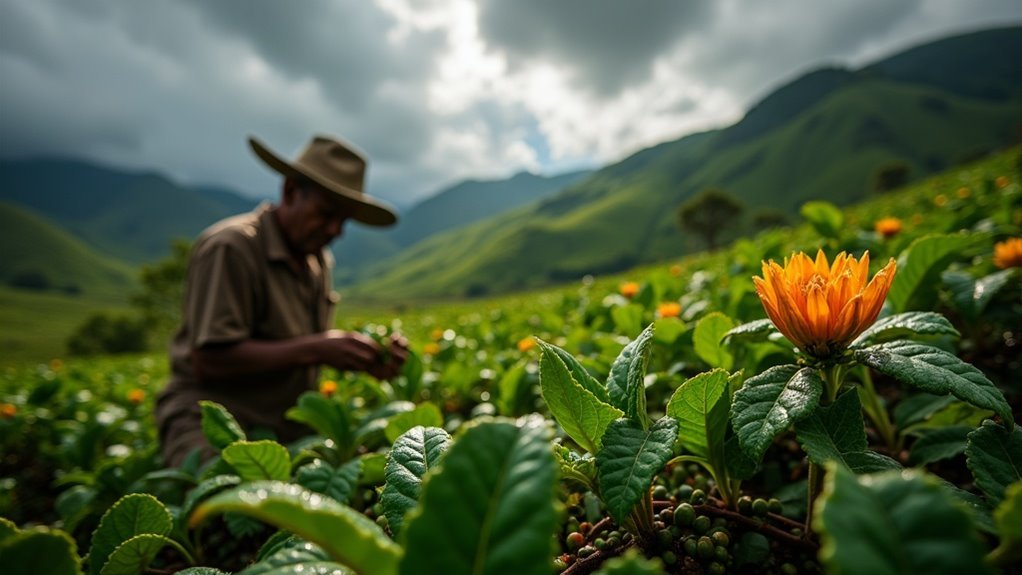Climate change significantly impacts coffee growing regions by raising temperatures, which could reduce suitable land for production by 50% by 2050. Erratic rainfall patterns disrupt coffee maturation and crop health, while increased warmth accelerates pest lifecycles and diseases. These factors lead to decreased yields and quality, adversely affecting farmers’ livelihoods. The economic and social implications are profound, threatening cultural practices and food security within coffee-producing communities. Understanding these challenges and exploring potential solutions can help mitigate the impacts on coffee cultivation, ensuring a sustainable future for this beloved beverage.
Key Takeaways
- Rising temperatures may reduce suitable land for coffee production by up to 50% by 2050, posing a significant threat to the global coffee supply.
- Erratic rainfall patterns disrupt the maturation of coffee cherries and the overall health of crops, increasing the risk of pests and diseases that can harm coffee plants.
- Warmer conditions accelerate the lifecycles of pests, resulting in higher infestations and potentially devastating damage to coffee crops.
- Decreased yields and compromised quality lead to price volatility, which directly impacts the livelihoods of smallholder coffee farmers and the economies of coffee-producing countries.
- To adapt to these changing conditions, it is crucial to develop climate-resilient coffee varieties and implement sustainable farming practices that support the long-term viability of coffee cultivation.
The Impact of Temperature Increases on Coffee Cultivation
As temperatures continue to rise due to climate change, you’re likely to see a significant impact on coffee cultivation. By 2050, suitable land for coffee production may decrease by 50%, particularly in renowned coffee-producing regions like Brazil, Vietnam, and Colombia.
Higher temperatures accelerate coffee plants’ metabolism, leading to quicker cherry maturation, but this often diminishes the rich flavor profiles that coffee lovers cherish. Alarmingly, climate models indicate that 47% of global coffee production will originate from regions that are projected to lose over 60% of suitable land.
Additionally, warmer conditions promote the proliferation of pests and diseases, such as coffee leaf rust, which further threatens yield and viability. As these challenges arise, traditional farming practices may struggle to adapt to shifting growing regions, impacting the quality and availability of your favorite coffee.
Changes in Rainfall Patterns and Their Effects
Unpredictable rainfall patterns, driven by climate change, pose significant challenges to coffee cultivation. Extended droughts and intense rainfall disrupt the maturation of coffee cherries and overall crop health.
In Central America, erratic rainfall fosters conditions for coffee leaf rust, jeopardizing yields. Increased rainfall can lead to flooding and landslides, damaging coffee crops and infrastructure while delaying harvests due to late cherry ripening.
Coffee farmers struggle to adapt, as inconsistent rainfall complicates their planting and harvesting schedules. Additionally, the predicted rise in extreme weather events threatens to diminish suitable land for coffee cultivation, with some regions facing potential losses of over 60% of their coffee production capacity by 2050.
Increased Risks From Pests and Diseases
With climate change intensifying, coffee-growing regions are facing increased risks from pests and diseases that threaten the health and yields of this beloved beverage.
Warmer temperatures accelerate pest lifecycles, leading to more generations per season and heightened infestations that can impact coffee quality. Moisture-loving insects thrive under increased rainfall, putting additional pressures on coffee farmers who strive to produce the best beans.
Coffee leaf rust, a significant pathogen, has previously devastated crops in Central America, posing a serious risk to coffee production. As conditions become increasingly favorable for these threats, farmers who lack resources and knowledge struggle to manage crop health effectively, jeopardizing their livelihoods and increasing vulnerability in an already challenging climate landscape, which could ultimately affect coffee lovers around the world.
Economic and Social Implications for Coffee Farmers
Increased pest pressures and shifting climatic conditions not only threaten coffee yields but also have significant economic and social implications for farmers in the coffee industry. Smallholder farmers, who contribute approximately 70% of the world’s coffee supply, are experiencing decreased yields and quality, which exacerbate price volatility. This instability directly impacts coffee exports, significantly influencing national GDP in coffee-producing countries like Ethiopia. Economic hardships faced by these farmers can lead to migration to urban areas, which in turn erodes traditional knowledge and cultural heritage associated with coffee cultivation. Ultimately, these challenges jeopardize food security, contributing to social instability and unrest in regions dependent on coffee.
| Economic Implications | Social Implications |
|---|---|
| Price Volatility | Migration |
| Reduced Exports | Cultural Loss |
| Increased Production Costs | Social Instability |
| Impact on GDP | Food Security |
Strategies for Adaptation and Sustainability in Coffee Production
As climate change continues to reshape coffee-growing regions, coffee farmers must adopt innovative strategies to ensure the sustainability and resilience of their crops.
Developing climate-resilient coffee varieties is crucial, especially as suitable land for coffee cultivation may decline by 50% by 2050.
Implementing agroforestry practices not only enhances biodiversity and soil health but also provides essential shade for coffee plants.
Efficient water management techniques, such as drip irrigation, are vital in combating the increased drought conditions that threaten coffee production.
Certification programs, including Fair Trade and Rainforest Alliance, promote sustainable farming practices and fair wages for coffee farmers, ensuring the long-term viability of coffee production.
Collaborative efforts among stakeholders in the coffee industry further foster adaptation strategies, enhancing productivity and sustainability in coffee production amidst the challenges posed by climate change.








